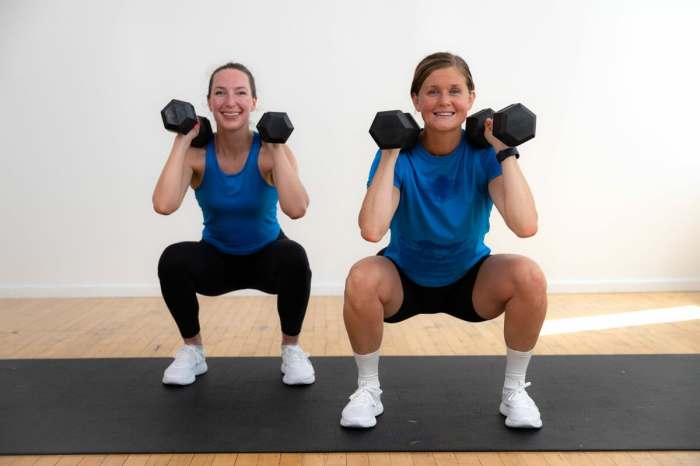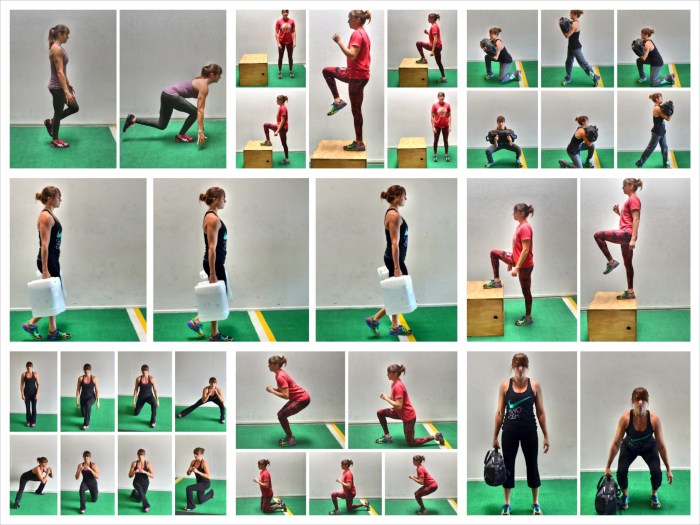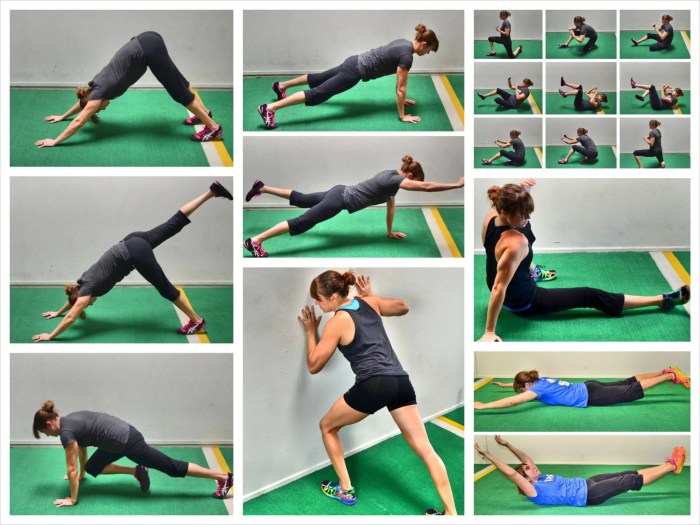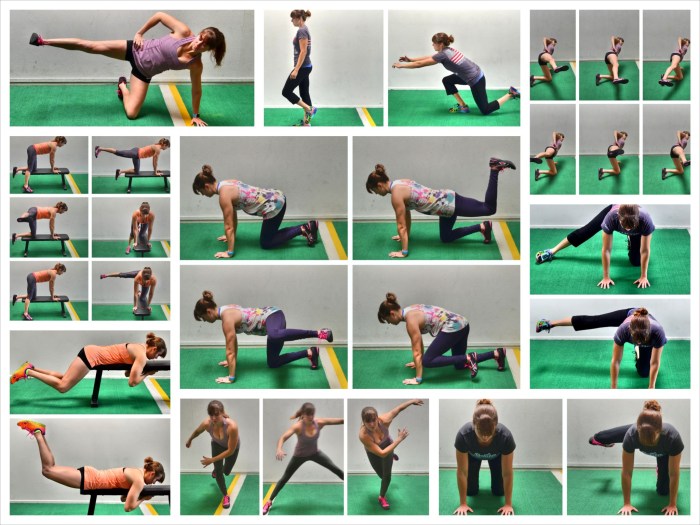Welcome to the ultimate guide to the best strength exercises for women! This comprehensive exploration delves into the transformative power of strength training, empowering you to unlock your physical potential and achieve your fitness goals.
Whether you’re a seasoned athlete or just starting your fitness journey, this guide provides an accessible and engaging roadmap to building strength, enhancing mobility, and boosting your overall well-being.
Compound Exercises
Compound exercises are a type of exercise that targets multiple muscle groups simultaneously. They are an excellent choice for women who want to maximize their workouts and get the most out of their time in the gym.
Some of the benefits of compound exercises for women include:
- They are more efficient than isolation exercises, which target only one muscle group at a time.
- They can help you burn more calories in a shorter amount of time.
- They can help you build strength and muscle mass.
- They can improve your balance and coordination.
Some examples of compound exercises that target multiple muscle groups include:
- Squats
- Lunges
- Deadlifts
- Push-ups
- Rows
It is important to use proper form when performing compound exercises. This will help you get the most out of your workouts and avoid injury.
Here are some tips for performing compound exercises with proper form:
- Keep your back straight and your core engaged.
- Use a weight that is challenging but not too heavy.
- Control the movement throughout the entire range of motion.
- Breathe deeply and exhale during the exertion phase of the exercise.
Compound exercises are a great way for women to improve their strength, muscle mass, and overall fitness. By following these tips, you can perform compound exercises safely and effectively.
Bodyweight Exercises

Bodyweight exercises are a great way for women to improve their strength, flexibility, and endurance. They’re also a convenient and affordable way to get in shape, as they can be done anywhere, anytime.One of the biggest advantages of bodyweight exercises is that they’re scalable.
This means that they can be modified to make them easier or harder, depending on your fitness level. For example, if you’re new to bodyweight exercises, you can start by doing bodyweight squats and push-ups on your knees. As you get stronger, you can progress to doing these exercises with your feet flat on the ground.
Effective Bodyweight Exercises for Different Fitness Levels
Here are some effective bodyweight exercises for women of all fitness levels: Beginner:
- Bodyweight squats
- Push-ups on knees
- Lunges
- Plank
- Bridge
Intermediate:
- Push-ups
- Pull-ups
- Dips
- Rowing
- Mountain climbers
Advanced:
- Pistol squats
- One-arm push-ups
- Handstand push-ups
- Burpees
- Turkish get-ups
Modifying Bodyweight Exercises
You can modify bodyweight exercises to make them easier or harder by changing the following variables:
Range of motion
The range of motion is the distance through which you move your body during an exercise. You can make an exercise easier by decreasing the range of motion, and harder by increasing the range of motion.
Tempo
The tempo is the speed at which you perform an exercise. You can make an exercise easier by slowing down the tempo, and harder by speeding up the tempo.
Resistance
The resistance is the amount of force that you have to overcome during an exercise. You can make an exercise easier by decreasing the resistance, and harder by increasing the resistance.
Resistance Band Exercises
Resistance band exercises are an excellent way for women to build strength, improve mobility, and enhance overall fitness. These bands offer versatility, portability, and adjustable resistance, making them suitable for various fitness levels and goals.
Exercises for Different Muscle Groups
- Chest:Chest press, flyes, push-ups
- Back:Rows, pull-downs, deadlifts
- Shoulders:Overhead press, lateral raises, front raises
- Arms:Bicep curls, tricep extensions, hammer curls
- Legs:Squats, lunges, calf raises, hip thrusts
- Core:Planks, crunches, leg raises
Choosing the Right Band, Best strength exercises for women
The appropriate resistance band depends on your strength and fitness level. Start with a lighter band and gradually increase resistance as you get stronger. Use a band that provides enough challenge while maintaining good form.
Free Weight Exercises
Free weight exercises involve using weights that are not attached to a machine, allowing for a greater range of motion and muscle activation. They offer several advantages for women:
Increased muscle mass and strength
Free weights challenge multiple muscle groups simultaneously, promoting muscle growth and strength gains.
Improved balance and coordination
Balancing free weights requires core engagement and improves overall stability.
Increased flexibility
The unrestricted range of motion in free weight exercises helps enhance flexibility.
Calorie expenditure
Free weight exercises are highly effective for burning calories, contributing to weight management.However, it’s crucial to note that free weight exercises also have some disadvantages:
Higher risk of injury
Improper technique can lead to injuries, especially for beginners.
May require a spotter
Certain exercises, like bench press, may require a spotter for safety.
Limited range of motion for some exercises
Some free weight exercises, like bicep curls, have a limited range of motion compared to machine exercises.
Exercises Targeting Different Muscle Groups
Free weight exercises can target various muscle groups:
Chest
Bench press, dumbbell flyes
Back
Barbell rows, pull-ups
Legs
Squats, lunges, deadlifts
Shoulders
Overhead press, lateral raises
Arms
Bicep curls, tricep extensions
Importance of Proper Technique
Proper technique is essential when lifting free weights to prevent injuries and maximize results:
Use a spotter when necessary
For heavy lifts or exercises where balance is compromised.
Warm up before lifting
Prepare your muscles and joints for the workout.
Maintain proper form
Keep your back straight, engage your core, and avoid excessive weight.
Control the weight
Lower and raise weights slowly, avoiding jerking or swinging motions.
Rest adequately
Allow your muscles to recover between sets to maintain proper form and reduce fatigue.
HIIT (High-Intensity Interval Training)
HIIT, or High-Intensity Interval Training, is a popular form of exercise that involves alternating between short bursts of intense activity and brief periods of rest or low-intensity exercise. This type of training has gained popularity in recent years due to its effectiveness in improving cardiovascular health, burning fat, and building muscle.
HIIT workouts are typically performed in a circuit format, where you complete a series of exercises one after the other with minimal rest in between. The exercises are usually performed at a high intensity, around 80-90% of your maximum heart rate.
The rest periods are typically short, around 15-30 seconds, and allow you to recover just enough to be able to perform the next exercise at a high intensity.
Benefits of HIIT for Women
HIIT offers several benefits for women, including:
- Weight loss:HIIT is a very effective way to burn fat. Studies have shown that HIIT can burn more calories than traditional steady-state cardio, and it can also help to boost your metabolism.
- Improved cardiovascular health:HIIT is a great way to improve your cardiovascular health. Studies have shown that HIIT can help to lower blood pressure, improve cholesterol levels, and reduce the risk of heart disease.
- Increased muscle mass:HIIT can help to increase muscle mass. Studies have shown that HIIT can stimulate muscle growth more effectively than traditional steady-state cardio.
HIIT Exercises
There are many different HIIT exercises that you can do. Some popular exercises include:
- Bodyweight squats
- Jumping jacks
- High knees
- Burpees
- Mountain climbers
You can do HIIT exercises with minimal equipment, which makes them a great option for home workouts. You can also do HIIT exercises at the gym or in a group fitness class.
Rest and Recovery
Rest and recovery are an important part of HIIT workouts. It’s important to listen to your body and rest when you need to. A good rule of thumb is to rest for about 15-30 seconds after each exercise. You should also take a longer rest break, around 2-3 minutes, after each circuit.
It’s also important to get enough sleep on the days that you do HIIT workouts. Sleep is essential for recovery and muscle growth.
Sample HIIT Workout Plan
Here is a sample HIIT workout plan that you can try:
| Exercise | Sets | Repetitions | Rest |
|---|---|---|---|
| Bodyweight squats | 3 | 15 | 15 seconds |
| Jumping jacks | 3 | 20 | 15 seconds |
| High knees | 3 | 25 | 15 seconds |
| Burpees | 3 | 10 | 30 seconds |
| Mountain climbers | 3 | 20 | 15 seconds |
This workout is designed to be challenging, but it’s important to listen to your body and rest when you need to. You can adjust the exercises, sets, repetitions, and rest periods to fit your own fitness level.
Risks of HIIT
HIIT is a safe and effective form of exercise, but there are some risks that you should be aware of. These risks include:
- Overtraining:HIIT workouts can be very demanding, so it’s important to avoid overtraining. Listen to your body and rest when you need to.
- Injury:HIIT workouts can be intense, so it’s important to warm up properly and use good form to avoid injury.
- Heart problems:HIIT workouts can put a strain on your heart, so it’s important to talk to your doctor before starting a HIIT program if you have any heart problems.
You can minimize the risks of HIIT by starting gradually and listening to your body. It’s also important to warm up properly before each workout and cool down afterwards.
Tips for Staying Motivated
Staying motivated with HIIT workouts can be challenging, but there are a few things you can do to stay on track:
- Set realistic goals:Don’t try to do too much too soon. Start with a few short HIIT workouts each week and gradually increase the intensity and duration of your workouts as you get stronger.
- Find a workout buddy:Working out with a friend can help you stay motivated and accountable.
- Listen to music:Listening to upbeat music can help you stay energized and motivated during your workouts.
- Track your progress:Tracking your progress can help you stay motivated and see how far you’ve come.
HIIT is a challenging but effective form of exercise that offers many benefits for women. By following these tips, you can stay motivated and reap the benefits of HIIT.
Core Strengthening Exercises
Core strength is essential for women, providing stability and support for the spine, pelvis, and hips. It enhances posture, balance, and overall mobility. Core exercises engage the abdominal, back, and pelvic floor muscles, improving core stability and reducing the risk of back pain and other injuries.
Incorporating Core Exercises into a Fitness Routine
Incorporating core exercises into a regular fitness routine can significantly enhance overall health and fitness. These exercises help strengthen the core muscles, which are responsible for maintaining proper posture, stabilizing the spine, and supporting the pelvic floor. By engaging in core exercises regularly, women can improve their balance, reduce the risk of back pain, and enhance their overall athletic performance.
Core Strengthening Exercises for Home
Numerous core strengthening exercises can be performed at home without requiring specialized equipment. These exercises include:
Plank
Hold a position with forearms on the ground and body in a straight line from head to heels.
Side Plank
Hold a position with one forearm on the ground and body in a straight line from head to feet.
Bird Dog
Start on hands and knees, then extend the right arm forward and the left leg backward simultaneously. Hold and return to the starting position.
Russian Twist
Sit on the floor with knees bent and feet off the ground. Twist the torso from side to side, keeping the core engaged.
Leg Raises
Lie on your back with legs extended. Lift both legs towards the ceiling, keeping the lower back pressed into the ground.
Pelvic Tilts
Lie on your back with knees bent and feet flat on the floor. Tilt the pelvis upward, flattening the lower back into the ground.
Benefits of Core Strengthening Exercises
Regularly performing core strengthening exercises offers numerous benefits, including:
- Improved posture and balance
- Reduced risk of back pain and injuries
- Enhanced athletic performance
- Increased stability and support for the spine, pelvis, and hips
- Improved core strength and endurance
- Better coordination and motor control
- Reduced risk of incontinence and pelvic organ prolapse
Flexibility and Mobility Exercises
Flexibility and mobility exercises are essential for women, especially those over 50. As we age, our bodies naturally lose flexibility and mobility, which can lead to pain, stiffness, and decreased range of motion. Flexibility exercises help to lengthen muscles, while mobility exercises improve the range of motion in joints.
Both are important for maintaining a healthy and active lifestyle.
Benefits of Flexibility and Mobility Exercises
There are many benefits to performing flexibility and mobility exercises regularly, including:
- Reduced pain and stiffness
- Improved range of motion
- Enhanced balance and coordination
- Reduced risk of injury
- Improved posture
- Increased energy levels
- Better sleep
Examples of Flexibility and Mobility Exercises
There are many different flexibility and mobility exercises that you can do. Some examples include:
- Stretching: This involves holding a position for a period of time to lengthen muscles.
- Dynamic stretching: This involves moving through a range of motion while gradually increasing the intensity.
- Foam rolling: This involves using a foam roller to massage and release tension in muscles.
- Yoga: This is a mind-body practice that combines stretching, strength training, and meditation.
- Tai chi: This is a gentle form of exercise that combines slow, flowing movements with deep breathing.
Warm-up Before Flexibility Exercises
It is important to warm up before performing flexibility exercises. This will help to prevent injuries. A good warm-up routine includes:
- 5-10 minutes of light cardio, such as walking or jogging
- Dynamic stretching for all major muscle groups
Incorporating Flexibility and Mobility Exercises into a Daily Routine
You can incorporate flexibility and mobility exercises into your daily routine in a variety of ways. Here is a sample schedule:
- Monday:Yoga
- Tuesday:Foam rolling
- Wednesday:Rest
- Thursday:Dynamic stretching
- Friday:Tai chi
- Saturday:Rest
- Sunday:Stretching
Listening to Your Body and Resting When Needed
It is important to listen to your body and rest when needed. If you experience any pain or discomfort, stop the exercise and consult with a healthcare professional. It is also important to take rest days to allow your body to recover.
Tips for Avoiding Injuries
Here are some tips for avoiding injuries when performing flexibility and mobility exercises:
- Start slowly and gradually increase the intensity of your exercises.
- Listen to your body and stop if you experience any pain or discomfort.
- Use proper form and technique.
- Warm up before exercising and cool down afterwards.
- Stay hydrated.
- Get enough sleep.
Yoga and Pilates

Yoga and Pilates are mind-body practices that offer a range of benefits for women. These practices combine physical poses, breathing exercises, and mindfulness to improve flexibility, strength, and overall well-being.Yoga emphasizes stretching and flexibility, while Pilates focuses on core strength and stability.
Both practices can help women:
- Improve posture and balance
- Increase flexibility and range of motion
- Strengthen muscles, especially the core
- Reduce stress and anxiety
- Improve sleep quality
Yoga Exercises for Home
Some beginner-friendly yoga poses that can be performed at home include:
- Downward-Facing Dog:Inverts the body, stretching the hamstrings, calves, and spine.
- Child’s Pose:Calms the mind and body, stretching the hips, thighs, and ankles.
- Cat-Cow Pose:Stretches the spine and massages the abdominal organs.
- Cobra Pose:Strengthens the back, opens the chest, and improves posture.
Pilates Exercises for Home
Beginner-friendly Pilates exercises that can be performed at home include:
- Hundred:Lying on the back, lift the head and shoulders while pumping the arms up and down.
- Roll-Up:Sitting on the floor, roll up to a seated position while engaging the core.
- Bird Dog:On hands and knees, extend the opposite arm and leg simultaneously.
- Bridge:Lying on the back, lift the hips towards the ceiling while squeezing the glutes.
Finding a Qualified Instructor
When practicing yoga or Pilates, it’s important to find a qualified instructor who can provide guidance and ensure proper form. This can help prevent injuries and maximize the benefits of the practice.
– Explain the benefits of functional fitness exercises for women, including improved balance, coordination, and mobility.: Best Strength Exercises For Women
Functional fitness exercises mimic everyday movements, improving your ability to perform daily tasks with ease. These exercises enhance balance, coordination, and mobility, making you more agile and graceful.
Functional fitness exercises also strengthen muscles used in everyday activities, reducing the risk of injury. They improve posture, flexibility, and range of motion, enhancing overall well-being.
Examples of Functional Fitness Exercises
- Squats: Strengthen legs, glutes, and core.
- Lunges: Improve balance, stability, and leg strength.
- Push-ups: Build upper body strength, core stability, and shoulder mobility.
- Rows: Strengthen back muscles, improving posture and preventing back pain.
- Planks: Engage core muscles, improving stability and reducing lower back pain.
Importance of Functional Fitness Exercises
- Enhance everyday activities: Functional fitness exercises improve strength, balance, and coordination, making daily tasks easier.
- Reduce risk of injury: By strengthening muscles used in everyday movements, functional fitness exercises help prevent injuries.
- Improve overall fitness: Functional fitness exercises provide a full-body workout, improving cardiovascular health, muscular strength, and flexibility.
Recovery and Nutrition
Recovery and nutrition are essential for women who are strength training. Getting enough rest and eating a healthy diet can help you maximize your results and avoid injury.
After a strength training workout, your muscles need time to repair themselves. This is why it’s important to get at least 7-8 hours of sleep each night. Sleep helps your body produce hormones that are essential for muscle growth and recovery.
In addition to sleep, nutrition is also important for recovery. Eating a healthy diet that includes plenty of protein, carbohydrates, and healthy fats can help you fuel your workouts and rebuild your muscles.
Healthy Foods for Muscle Growth and Recovery
- Lean protein: chicken, fish, tofu, beans, lentils
- Complex carbohydrates: brown rice, quinoa, oatmeal, whole-wheat bread
- Healthy fats: avocados, nuts, seeds, olive oil
- Fruits and vegetables: provide vitamins, minerals, and antioxidants
Importance of Hydration
It’s also important to stay hydrated when you’re strength training. Dehydration can lead to fatigue, muscle cramps, and dizziness.
Aim to drink 8-10 glasses of water per day, especially before and after your workouts.
Sample Meal Plan
Here is a sample meal plan that includes specific food recommendations and portion sizes for women who are strength training:
| Meal | Foods | Portion Sizes |
|---|---|---|
| Breakfast | Oatmeal with berries and nuts | 1 cup cooked oatmeal, 1/2 cup berries, 1/4 cup nuts |
| Lunch | Grilled chicken salad with brown rice | 4 ounces grilled chicken, 1 cup brown rice, 1 cup mixed greens, 1/2 cup vegetables |
| Dinner | Salmon with roasted vegetables | 4 ounces salmon, 1 cup roasted vegetables, 1/2 cup quinoa |
| Snacks | Fruit, yogurt, nuts | 1 apple, 1 cup yogurt, 1/4 cup nuts |
Sample Weekly Workout Plan
Here is a sample weekly workout plan that incorporates rest and recovery days:
- Monday: Strength training
- Tuesday: Rest
- Wednesday: Strength training
- Thursday: Rest
- Friday: Strength training
- Saturday: Rest
- Sunday: Active recovery (e.g., yoga, walking)
Safety Considerations

Strength training exercises, when performed correctly, can be incredibly beneficial for women. However, it’s crucial to prioritize safety to minimize the risk of injuries and ensure optimal results.
Common Mistakes to Avoid
1. Improper Form
Maintaining proper form is essential for preventing injuries and maximizing the effectiveness of exercises. Avoid arching your back, rounding your shoulders, or using momentum instead of engaging the target muscles.
2. Lifting Too Much Weight
Start with a weight that challenges you but allows you to maintain good form. Gradually increase the weight as you get stronger.
3. Not Warming Up Properly
Warming up prepares your body for the demands of strength training. Begin with light cardio and dynamic stretching to increase blood flow and reduce the risk of strains.
4. Not Cooling Down Properly
Cooling down helps your body recover and reduces muscle soreness. Include static stretching in your cooldown routine.
5. Not Getting Enough Rest
Allow your muscles adequate time to recover between workouts. Overtraining can lead to injuries and hinder progress.
Listen to Your Body
Pay attention to how your body responds during and after exercises. If you experience pain, stop the exercise and consult a healthcare professional. Rest when needed to avoid overexertion and allow for proper recovery.
Spotters and Nutrition
Consider using a spotter for exercises involving heavy weights or complex movements. A spotter provides support and assistance, reducing the risk of accidents.Proper nutrition and hydration are crucial for strength training. Consume a balanced diet with adequate protein to support muscle growth and repair.
Stay hydrated by drinking plenty of water before, during, and after workouts.
Consultation and Underlying Health Conditions
Before starting a strength training program, consult with a healthcare professional, especially if you have any underlying health conditions. They can provide guidance and ensure that the exercises are safe and appropriate for you.
Sample Workout Plan
For women new to strength training, starting with a well-structured workout plan is crucial. This plan should target different muscle groups, promote gradual progression, and emphasize proper form.
The following table Artikels a sample workout plan for beginners, focusing on compound exercises that work multiple muscle groups simultaneously:
| Exercise | Sets | Reps | Rest |
|---|---|---|---|
| Squat | 3 | 10-12 | 60 seconds |
| Push-up | 3 | 8-10 | 60 seconds |
| Row | 3 | 10-12 | 60 seconds |
| Lunge | 3 | 10-12 per leg | 60 seconds |
| Plank | 3 | Hold for 30-60 seconds | 60 seconds |
Proper Form and Technique:
- Squat: Keep your back straight, chest up, and knees aligned with your toes.
- Push-up: Lower your chest towards the ground while keeping your elbows close to your body.
- Row: Pull the weight towards your chest while keeping your back straight and core engaged.
- Lunge: Step forward with one leg and lower your body until your front thigh is parallel to the ground.
- Plank: Hold a position with your forearms on the ground and your body in a straight line from head to heels.
Common Mistakes to Avoid:
- Using too much weight: Start with a weight that is challenging but allows you to maintain proper form.
- Rushing through reps: Focus on controlled movements and proper form rather than speed.
- Ignoring rest periods: Rest is essential for muscle recovery and preventing injuries.
- Neglecting warm-up and cool-down: Warm up before each workout and cool down afterwards to reduce the risk of injuries.
- Overtraining: Gradually increase the intensity and duration of your workouts to avoid burnout and injuries.
Staying Motivated and Making Strength Training a Regular Habit:
- Set realistic goals: Don’t try to do too much too soon. Start small and gradually increase your intensity and duration.
- Find an activity you enjoy: If you don’t enjoy your workouts, you’re less likely to stick with them.
- Find a workout buddy: Having someone to train with can provide support and motivation.
- Track your progress: Keep a journal or use a fitness tracker to monitor your progress and stay motivated.
- Reward yourself: Celebrate your successes, no matter how small.
Key Points:
- Start with a weight that is challenging but allows you to maintain proper form.
- Focus on controlled movements and proper form rather than speed.
- Rest is essential for muscle recovery and preventing injuries.
- Gradually increase the intensity and duration of your workouts to avoid burnout and injuries.
- Set realistic goals, find an activity you enjoy, and find a workout buddy to stay motivated.
Success Stories and Testimonials

Strength training has transformed the lives of countless women, leading to remarkable improvements in their physical and mental well-being. Here are a few inspiring stories:
Example 1:Sarah, a 45-year-old mother of two, struggled with chronic back pain. After starting a strength training program, her pain subsided significantly, and she gained confidence and strength.
Example 2:Emily, a 28-year-old office worker, felt weak and unmotivated. Strength training boosted her energy levels, improved her posture, and gave her a sense of empowerment.
The Power of Community
Joining a supportive community can significantly enhance the strength training journey. Connecting with like-minded women provides motivation, accountability, and a sense of belonging. Women who share their experiences and offer encouragement can make a profound difference in progress and long-term success.
Final Wrap-Up

Incorporating strength training into your routine is not just about aesthetics; it’s about empowering yourself with a stronger body, a sharper mind, and an unwavering determination to conquer any challenge that comes your way.
Remember, strength is not just a physical attribute; it’s a mindset that empowers you to embrace life’s adventures with confidence and resilience.
FAQ Insights
How often should women strength train?
Aim for 2-3 strength training sessions per week, targeting different muscle groups each session.
What are the benefits of strength training for women over 50?
Strength training helps maintain bone density, improves balance and coordination, and reduces the risk of falls.
Is it safe for women to lift heavy weights?
Yes, with proper form and technique. Start gradually and increase weight as you progress.
Leave a Reply